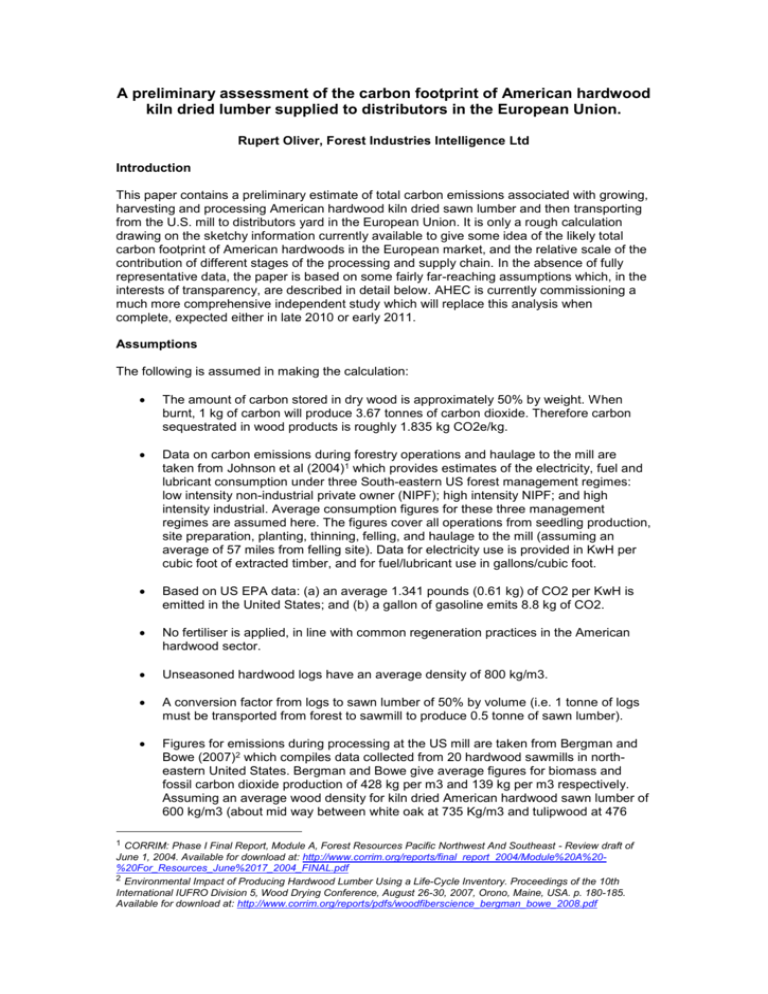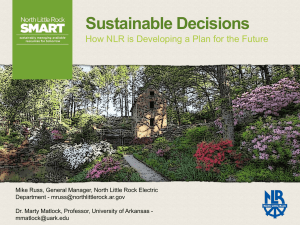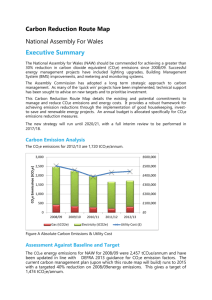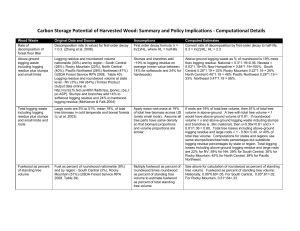Preliminary calculation of carbon emissions associated with
advertisement

A preliminary assessment of the carbon footprint of American hardwood kiln dried lumber supplied to distributors in the European Union. Rupert Oliver, Forest Industries Intelligence Ltd Introduction This paper contains a preliminary estimate of total carbon emissions associated with growing, harvesting and processing American hardwood kiln dried sawn lumber and then transporting from the U.S. mill to distributors yard in the European Union. It is only a rough calculation drawing on the sketchy information currently available to give some idea of the likely total carbon footprint of American hardwoods in the European market, and the relative scale of the contribution of different stages of the processing and supply chain. In the absence of fully representative data, the paper is based on some fairly far-reaching assumptions which, in the interests of transparency, are described in detail below. AHEC is currently commissioning a much more comprehensive independent study which will replace this analysis when complete, expected either in late 2010 or early 2011. Assumptions The following is assumed in making the calculation: 1 The amount of carbon stored in dry wood is approximately 50% by weight. When burnt, 1 kg of carbon will produce 3.67 tonnes of carbon dioxide. Therefore carbon sequestrated in wood products is roughly 1.835 kg CO2e/kg. Data on carbon emissions during forestry operations and haulage to the mill are taken from Johnson et al (2004)1 which provides estimates of the electricity, fuel and lubricant consumption under three South-eastern US forest management regimes: low intensity non-industrial private owner (NIPF); high intensity NIPF; and high intensity industrial. Average consumption figures for these three management regimes are assumed here. The figures cover all operations from seedling production, site preparation, planting, thinning, felling, and haulage to the mill (assuming an average of 57 miles from felling site). Data for electricity use is provided in KwH per cubic foot of extracted timber, and for fuel/lubricant use in gallons/cubic foot. Based on US EPA data: (a) an average 1.341 pounds (0.61 kg) of CO2 per KwH is emitted in the United States; and (b) a gallon of gasoline emits 8.8 kg of CO2. No fertiliser is applied, in line with common regeneration practices in the American hardwood sector. Unseasoned hardwood logs have an average density of 800 kg/m3. A conversion factor from logs to sawn lumber of 50% by volume (i.e. 1 tonne of logs must be transported from forest to sawmill to produce 0.5 tonne of sawn lumber). Figures for emissions during processing at the US mill are taken from Bergman and Bowe (2007)2 which compiles data collected from 20 hardwood sawmills in northeastern United States. Bergman and Bowe give average figures for biomass and fossil carbon dioxide production of 428 kg per m3 and 139 kg per m3 respectively. Assuming an average wood density for kiln dried American hardwood sawn lumber of 600 kg/m3 (about mid way between white oak at 735 Kg/m3 and tulipwood at 476 CORRIM: Phase I Final Report, Module A, Forest Resources Pacific Northwest And Southeast - Review draft of June 1, 2004. Available for download at: http://www.corrim.org/reports/final_report_2004/Module%20A%20%20For_Resources_June%2017_2004_FINAL.pdf 2 Environmental Impact of Producing Hardwood Lumber Using a Life-Cycle Inventory. Proceedings of the 10th International IUFRO Division 5, Wood Drying Conference, August 26-30, 2007, Orono, Maine, USA. p. 180-185. Available for download at: http://www.corrim.org/reports/pdfs/woodfiberscience_bergman_bowe_2008.pdf kg/m3) these figures imply emissions of 0.713 CO2e/kg from the burning of biomass and 0.232 CO2e/kg from the burning of fossil fuels. Transport distance of 500km by road to port in the United States – a reasonable allowance given that American hardwood producing areas are concentrated in the East Coast region. Transport distance of 6200km by sea. This is the distance from Baltimore (a large port located around the mid point of the US East Coast) to Rotterdam (Europe’s largest port). Transport distance of 500km by road to user in Europe – this would be sufficient to transport wood from Rotterdam throughout the Benelux countries, Northern France, and most of Germany. These allowances would probably exceed those typically required to distribute American hardwoods throughout the United Kingdom, Ireland, Portugal and Spain. A marine emission factor of 11 g CO2e/t-km which is equivalent to the figure used by CN, the Canadian railway company, in their “Greenhouse Gas Calculator” (GGC)3 A truck emission factor of 114 g CO2e/t-km, also drawing on the CN GGC. 4 Calculation Factor Working Carbon storage in wood Volume of carbon in 1 kg wood (0.5kg) X carbon dioxide equivalent (3.67) Johnson et al indicate consumption of fuel & lubricants = 0.058 gallons/ft3 = 0.51 kg CO2/ft3 = 18 kg CO2e/m3 = 0.0225 kg CO2e/kg. Divide by 0.5 to take account of conversion to sawn lumber. Johnson et al report 0.0037 KwH/ft3 = 0.0023 kg CO2e/ft3 = 0.08 kg CO2e/m3 = negligible amounts per kg of product. Derived from Bergman and Bowe (2007) study of 20 north-eastern sawmills. Bergman and Bowe report biomass emissions of 0.713 kg CO2e/kg. These are considered carbon neutral. 500km X 114g = 57000 g = 57 kg CO2/tonne of product 6200km X 11g = 68200g = 68.2 kg CO2/tonne of product 500km X 114g = 57000 g = 57 kg CO2/tonne of product Emissions from fuel/lubricant use during forestry operations and haulage to mill Emissions from electricity use during forest operations Emissions from burning of fossil fuel during processing at the US mill Emissions from burning of biomass (i.e. mainly wood waste) during processing at US mill Emissions during transport from mill to port in the US Emissions during sea transport Emissions during transport from port to European distributor Totals Overall emissions 3 Carbon Emissions sequestration kg CO2 equivalent per kg of product -1.835 0.045 0 0.232 0 0.057 0.068 0.057 -1.835 Emissions of 0.459 less 1.835 avoided emissions due to storage in wood 0.459 -1.376 The CN GGC is available at http://www.cn.ca/en/corporate-citizenship-environment-greenhouse-gascalculator.htm). CN draw in turn on various technical studies, which indicate that the emissions factors for larger container ships (post-Panamex container vessels greater than 4,400 TEU) are in the range of 10-12 g CO2e/t-km. These studies are: (1) World Resource Institute (WRI), CO2 emissions from transport or mobile sources calculation tool, http://www.ghgprotocol.org/calculation-tools/all-tools; (2) National Technical University of Athens Laboratory for Maritime Transport, Ship Emissions Study (May 2008) available at: http://www.martrans.org/documents/2008/sft/final%20report%20v10.2.pdf; and (3) Transport and Environment Database System (TRENDS): Maritime air pollutant emission modelling. Atmospheric Environment 39 (2005) 2357– 2365, by Georgakaki, Aliki et al. 4 CN state that this figure is a heavy truck emissions factor calculated using diesel fuel consumption data from Statistics Canada's Trucking in Canada 1995 survey for for-hire trucking companies with revenues greater than $1M, combined with tonne-km data from Statistics Canada's For-Hire Trucking Commodity Origin/Destination Survey 1995. CN also note that this figure is in the middle range compared to emission factors published by or calculated based on other sources (Environment Canada; Statistics Canada). Observations Sequestration of carbon during the growth of the tree more than offsets the total carbon emissions resulting from harvesting, processing and transporting of American hardwoods to European distributors. Transport is a relatively minor factor in the overall carbon footprint of American hardwoods. This is particularly true of ocean transport. Transporting American hardwoods by ship across the Atlantic requires little more energy than an overland journey of 500 km. In fact a complete circumnavigation of the world by sea (40000 km) would add only 0.44 kg CO2e/kg to the overall footprint and would be readily offset by the carbon sequestered in the wood product. Heavy dependence on biomass rather than fossil fuel energy during processing is a particularly important factor in keeping the overall carbon footprint of American hardwoods low. Even if the considerable benefits of carbon sequestration in American hardwood products were not considered, emissions of 0.459 kg CO2e/kg compare very favourably against other materials - including most domestic European wood and non-wood products and recycled materials. For example, comparative data from the UK is provided in the table below. Embodied carbon of common building materials in the UK Material Embodied carbon (kg CO2e/kg)(b) Virgin aluminium 11.45 Stainless steel 6.16 Wool 5.48 Carpet 3.89 Virgin steel 2.75 Plastics 2.53 PVC 2.41 Vinyl flooring 2.29 Recycled aluminium 1.69 Glass 0.86 Cement 0.83 Plywood(a) 0.81 Glulam(a) 0.65 Cement with 25% fly ash replacement 0.62 Ceramic tiles 0.59 MDF(a) 0.59 Timber consumed in the UK (average) (a) 0.48 American hardwood KD sawn (incl. transport from U.S. to N. Europe) (a) 0.46 Recycled steel 0.43 Cement with 50% fly ash replacement 0.42 American hardwood KD sawn (excl. transport from U.S. to N. Europe) (a) 0.35 (a) All figures for timber exclude carbon sequestered during forest growth. If carbon sequestration is included, timber products have a negative carbon balance (i.e. they store more carbon than they consume during manufacture). (b) Source for products other than American hardwoods: University of Bath, UK, “Inventory of Carbon Emissions” (ICE, Version 1.6a, 2008). Available at: http://people.bath.ac.uk/cj219/ Rupert Oliver Forest Industries Intelligence Limited For AHEC, 4 March 2010










